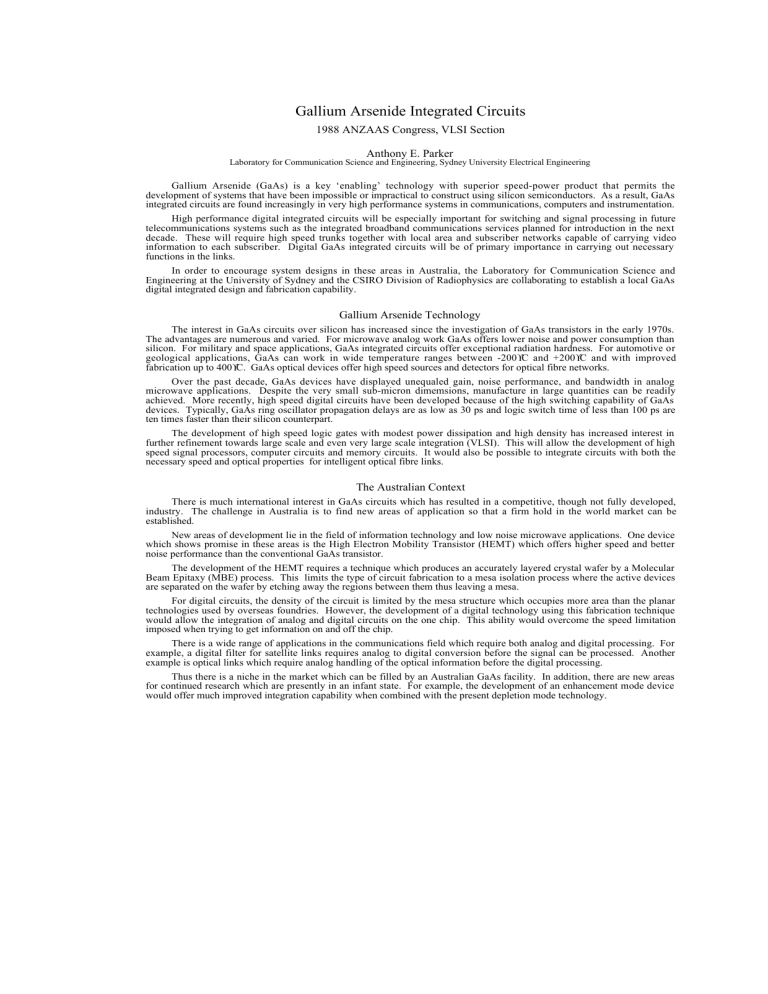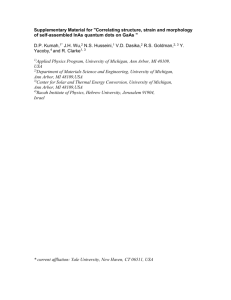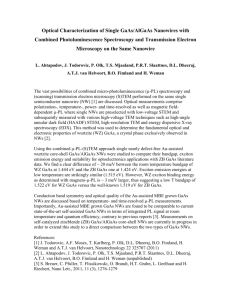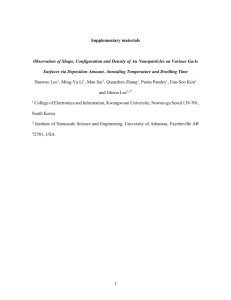Gallium Arsenide Integrated Circuits

Gallium Arsenide Integrated Circuits
1988 ANZAAS Congress, VLSI Section
Anthony E. Parker
Laboratory for Communication Science and Engineering, Sydney University Electrical Engineering
Gallium Arsenide (GaAs) is a key ‘enabling’ technology with superior speed-power product that permits the development of systems that have been impossible or impractical to construct using silicon semiconductors. As a result, GaAs integrated circuits are found increasingly in very high performance systems in communications, computers and instrumentation.
High performance digital integrated circuits will be especially important for switching and signal processing in future telecommunications systems such as the integrated broadband communications services planned for introduction in the next decade. These will require high speed trunks together with local area and subscriber networks capable of carrying video information to each subscriber. Digital GaAs integrated circuits will be of primary importance in carrying out necessary functions in the links.
In order to encourage system designs in these areas in Australia, the Laboratory for Communication Science and
Engineering at the University of Sydney and the CSIRO Division of Radiophysics are collaborating to establish a local GaAs digital integrated design and fabrication capability.
Gallium Arsenide Technology
The interest in GaAs circuits over silicon has increased since the investigation of GaAs transistors in the early 1970s.
The advantages are numerous and varied. For microwave analog work GaAs offers lower noise and power consumption than silicon. For military and space applications, GaAs integrated circuits offer exceptional radiation hardness. For automotive or geological applications, GaAs can work in wide temperature ranges between -200
°
C and +200
°
C and with improved fabrication up to 400
°
C. GaAs optical devices offer high speed sources and detectors for optical fibre networks.
Over the past decade, GaAs devices have displayed unequaled gain, noise performance, and bandwidth in analog microwave applications. Despite the very small sub-micron dimemsions, manufacture in large quantities can be readily achieved. More recently, high speed digital circuits have been developed because of the high switching capability of GaAs devices. Typically, GaAs ring oscillator propagation delays are as low as 30 ps and logic switch time of less than 100 ps are ten times faster than their silicon counterpart.
The development of high speed logic gates with modest power dissipation and high density has increased interest in further refinement towards large scale and even very large scale integration (VLSI). This will allow the development of high speed signal processors, computer circuits and memory circuits. It would also be possible to integrate circuits with both the necessary speed and optical properties for intelligent optical fibre links.
The Australian Context
There is much international interest in GaAs circuits which has resulted in a competitive, though not fully developed, industry. The challenge in Australia is to find new areas of application so that a firm hold in the world market can be established.
New areas of development lie in the field of information technology and low noise microwave applications. One device which shows promise in these areas is the High Electron Mobility Transistor (HEMT) which offers higher speed and better noise performance than the conventional GaAs transistor.
The development of the HEMT requires a technique which produces an accurately layered crystal wafer by a Molecular
Beam Epitaxy (MBE) process. This limits the type of circuit fabrication to a mesa isolation process where the active devices are separated on the wafer by etching away the regions between them thus leaving a mesa.
For digital circuits, the density of the circuit is limited by the mesa structure which occupies more area than the planar technologies used by overseas foundries. However, the development of a digital technology using this fabrication technique would allow the integration of analog and digital circuits on the one chip. This ability would overcome the speed limitation imposed when trying to get information on and off the chip.
There is a wide range of applications in the communications field which require both analog and digital processing. For example, a digital filter for satellite links requires analog to digital conversion before the signal can be processed. Another example is optical links which require analog handling of the optical information before the digital processing.
Thus there is a niche in the market which can be filled by an Australian GaAs facility. In addition, there are new areas for continued research which are presently in an infant state. For example, the development of an enhancement mode device would offer much improved integration capability when combined with the present depletion mode technology.
How we are taking up the Challenge
The Laboratory for Communication Science and Engineering at the University of Sydney and the CSIRO Division of
Radiophysics are collaborating to establish a local GaAs digital integrated design and fabrication capability. To achieve this goal, we are focussing on the production of a high-speed digital filter for use in the demodulation circuit of a satellite receiver.
At present, such a filter can not be implemented with commercial integrated circuit technologies as data rates are too high (120
Mbits/sec). The challenge is to implement the design by developing the high speed potential of Gallium Arsenide digital integrated circuit technology.
The present state-of-the-art in GaAs digital circuits is larger and more power hungry than their silicon equivalents.
However, the speed advantage outweighs the disadvantages. The challenges faced in the development include adapting to a new fabrication technique which impose limitations on the type of circuit that can be made and developing computer tools which enable rapid design and verification.
The work is at the stage where the building blocks for the implementation of the digital filter can now be produced.
Fabrication Capability
The Division of Radiophysics has a GaAs laboratory for developing microwave devices including the HEMT and are also able to fabricate digital integrated circuits. The fabrication process uses the mesa isolation technique and airbridges to achieve cross overs between two levels of wiring. Active devices available are the Schottky barrier diode and the depletion mode MEtal Semiconductor Field Effect Transistor (MESFET) and the HEMT.
Development of a Design Facility
At the University of Sydney, a conservative set of design rules for circuit layout has been developed after careful consideration of lithography, alignment, processing and electrical design requirements. The limiting consideration is lithography which restricts the minimum feature size to 1.5 microns. Sub-micron features which call for electron beam lithography will be available soon and allow the production of even faster circuits.
In addition, fundamental work has concentrated on the requirement to accurately model Schottky barrier diodes and
MESFETs with computer tools. The study of the electrical properties and physical details of the devices has led to the development of a new and detailed model which has been added to the existing silicon based circuit simulator. It has taken considerable effort to overcome the limitations of recently proposed models, which were designed for specific applications, and generally do not fit our measured data.
The fabrication process being developed in Australia by the CSIRO is being used as the basis for developing design procedures and circuit layout rules. The approach is oriented towards easy adaptation as process techniques improve. A set of basic logic circuits have been developed so that complex circuits can be fabricated by combining these in a rapid systematic manner. This is the forerunner to the establishment of a GaAs logic circuit design facility tailored to the anticipated local capability.
Our research is continuing with the study and development of the HEMT. It is also planned that research into the development of enhancement mode technology as well as applications such as intelligent data links and signal processors will be established.
Educational Programme
The early introduction of educational courses at the University of Sydney is viewed as an important contribution which will establish a base of design engineers able to use GaAs technology. GaAs integrated circuit design courses have been run and further courses, including an intensive industry-oriented course, are being planned.
Conclusion
This collaborative establishment of an Australian GaAs digital integrated circuit technology addresses not only the development of a broad range of technical expertise but also the need to transfer these skills to industry. Thus the establishment of the GaAs capability has three goals;
1.
to develop the design, fabrication, packaging and testing techniques needed to produce custom GaAs logic circuits;
2.
to establish a GaAs logic circuit design facility with skills accessible to a competitive Australian industry;
3.
to raise industry awareness of, and skills in, GaAs design through an educational programme involving specialist seminars and courses.
Already the building blocks for the design and development of communication equipment such as a digital filter are available. In addition, even more ambitious projects and research programmes have been commenced. This is an exciting time for this field in which we will see the growth of a new and competitive industry in Australia in the very near future.







